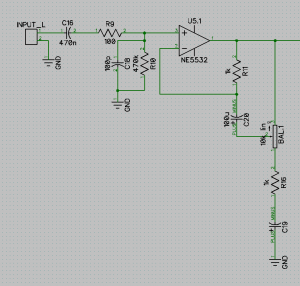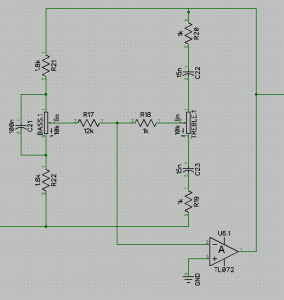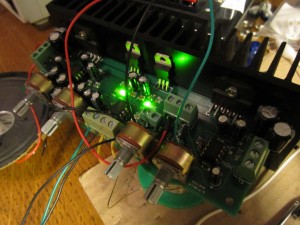This project description details the design and construction of a stereo audio amplifier based on the integrated power OPamp LM3886. The IC is capable of an output power of up to 68W continuously into a 4-ohm load, and 50W into an 8-ohm load.
The final amplifier can be seen here in a video demo: http://www.youtube.com/watch?v=E3Yylcnw_54
And here is a photograph:
The application of the LM3886 is very simple, consisting largely of a feedback network to your desire, rolled off to unity gain at DC, along with some decoupling capacitors.
Since the IC itself takes up a quite small amount of space, I decided to fill up a 5×15 cm PCB with two of them in stereo configuration, along with a preamplifier with volume, balance and tone controls. The preamplifier was inspired largely by the book Small signal audio design by Douglas Self (a very, very good book on the subject).
The preamplifier is basically made up of three separate blocks:

- Input buffer and balance gain stage The input buffer presents a high
 impedance at audio frequencies to prevent signal attenuation. It blocks DC, and also shorts high frequency signals to ground. The same OPamp used to buffer the signal is also used as a variable gain stage with a stereo balance potentiometer, where a wiper movement will produce a gain increase in one channel and a decrease in the other. This does not allow for completely silencing one side, but that is also not really a useful or necessary function to have for everyday use.
impedance at audio frequencies to prevent signal attenuation. It blocks DC, and also shorts high frequency signals to ground. The same OPamp used to buffer the signal is also used as a variable gain stage with a stereo balance potentiometer, where a wiper movement will produce a gain increase in one channel and a decrease in the other. This does not allow for completely silencing one side, but that is also not really a useful or necessary function to have for everyday use. - Treble and bass response tone control The tone control used is a
 conventional baxandall feedback circuit based around an OPamp. The feedback network provides one path for bass signals and another for treble signals, leveling out to unity gain at mid-range frequencies. Two potentiometers are used to control the gain of the bass and treble paths. For a 10k potentiometer, the dynamic range levels out to roughly +-22dB for both bass and treble.
conventional baxandall feedback circuit based around an OPamp. The feedback network provides one path for bass signals and another for treble signals, leveling out to unity gain at mid-range frequencies. Two potentiometers are used to control the gain of the bass and treble paths. For a 10k potentiometer, the dynamic range levels out to roughly +-22dB for both bass and treble. - Volume control The volume control is an active
 volume control, allowing a gain range of (approximately) negative infinity up to +18dB. The neat thing about the circuit used (also invented by P. Baxandall), is that it depends solely on the wiper position of the pot, and not on the actual varying pot resistance. This means that resistance track imbalance on a stereo pot will never turn up as channel volume imbalance when using this circuit for a stereo volume control. This is done by having a fixed amplifying (inverting) chain of opamps with +18dB gain, which is then coupled back to the input through the potentiometer.
volume control, allowing a gain range of (approximately) negative infinity up to +18dB. The neat thing about the circuit used (also invented by P. Baxandall), is that it depends solely on the wiper position of the pot, and not on the actual varying pot resistance. This means that resistance track imbalance on a stereo pot will never turn up as channel volume imbalance when using this circuit for a stereo volume control. This is done by having a fixed amplifying (inverting) chain of opamps with +18dB gain, which is then coupled back to the input through the potentiometer.
The preamplifier is driven from 7815 and 7915 supply regulation circuitry.
The output stage after the preamplifier is a typical application of the LM3886-IC and can be found here: http://www.national.com/mpf/LM/LM3886.html#Overview
And my schematic version of it:
The gain of the LM3886 is set to +22, and the mute signal is led out through the same screw terminal as the output signal to allow for adding an external mute switch on the amplifier chassis.
Things I should have done differently:
- Rearranged the layout so that all screw terminals were at the PCB edge. It was hard to connect wires to the supply and ground terminals.
- Should have chosen suitable potentiometer knobs and measured up appropriate distance before doing the PCB. As it was, the space between knobs became a bit tight, and I could not use as big knobs as I later decided that I wanted.
- Could have added a simple zobel capacitor + resistor on the output to avoid HF-instability.
- Should have checked capacitor sizes beforehand. Had to use some 25V-caps due to space problems on the PCB, so the amp cannot run on full power without risking cap wear and tear.


